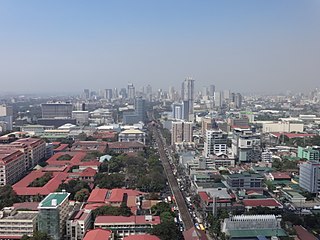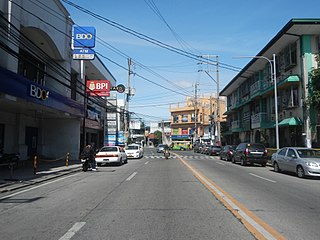History
In March 1969, the Aerospace Association of the Philippines created the Aerospace Cadets of the Philippines. It was for young men and women who have a predilection towards aviation-related industries.
On December 28, 1977, the Department of Education, Culture and Sports (presently the Department of Education) established the ACP program as a substitute for Citizen Army Training requirement, under Department of Education Order #64 series 1977, "The Creation and Organization of Aerospace Cadets of the Philippines".
By 1983, five schools were affiliated with the ACP program, making it a requirement in their curriculum for all students whose citizenship is Filipino. Today, male and female Filipino students of the five ACP-affiliated schools take ACP as one of their subjects.
On May 17, 2001, the DECS Secretary issued DECS Memorandum #166 for the Training Program of the Aerospace Cadets of the Philippines in Selected Private Secondary Schools in the Philippines.
Curriculum
The current program of instruction for ACP is 40% Aviation Education, and 60% Leadership, Citizenship and Military training.
Leadership
Students learn to value leadership by respecting their commanding officers, majority of which are students themselves who have earned their rank through training after school hours. Officers, likewise, have to learn not to abuse their power and learn humility, as well as leading by example.
These are the ranks of ACP, from highest to lowest:
- Cadet Colonel (C/COL)
- Cadet Lieutenant Colonel (C/LTC)
- Cadet Major (C/MAJ)
- Cadet Captain (C/CPT)
- Cadet First Lieutenant (C/1LT)
- Cadet Second Lieutenant (C/2LT)
- Cadet Probationary Second Lieutenant (C/P2LT)
- Cadet Master Sergeant (C/MSG)
- Cadet Technical Sergeant (C/TSG)
- Cadet Staff Sergeant (C/SSG)
- Cadet Sergeant (C/SGT)
- Cadet Airman/Airwoman First Class (C/A1C)
- Cadet Airman/Airwoman Second Class (C/A2C)
- Cadet Airman/Airwoman (C/AM, C/AW)
- Cadet New Recruit (C/NR)
However, it is also possible to become a medic, flag bearer (also known as a guidon bearer), or member of the air police or marching band of the ACP. Most students begin at the lowest rank, Cadet New Recruit, when they begin ACP at their school. It is possible for a Cadet to ascend in ranks if the Cadet’s performance is excellent, and it is also possible to receive demotions and lower the rank of a Cadet if he performs poorly or disrespects his commanding officer.
Citizenship
Cadets in the ACP learn patriotism and pride in their nationality, and are punished for disrespecting their homeland, the Philippines. For example, cadets are punished if they run during the playing or singing of the Philippine National Anthem. Cadets are likewise punished even more severely for disrespecting the Philippine flag (letting any portion of the flag touch the ground is worthy of a demotion). Cadets are encouraged to sing the National Anthem with pride. Cadets are also encouraged to recite the Panatang Makabayan and the Panunumpa ng Katapatan sa Watawat, as well as sing their school's alma mater song with zest and valor.
Military training
Being an extension of the Philippine Air Force, ACP requires students to learn military commands, drills, punishments, the military alphabet, and obedience to the commanding officer. Commands are mostly in Tagalog, such as 'Manumbalik', 'Humanay', 'Tikas', 'Paluwag', 'Pasulong', 'Lihis pakanan/pakaliwa', 'Liko pakanan/pakaliwa', and 'Kaliwang/Kanang panig'. Cadets also learn how to handle an M16 rifle, however, guns are forbidden in schools, so replicas of M16 rifles are used instead, and the proper use of sabers. ACP requires students to wear a military uniform (Known in some schools as General Officers Attire or GOA, and in others as General Officers Uniform or GOU), which is inspected every training day (this includes the proper military haircut of the boys and hair do for girls). Also, ACP cadets have their own Cadet Oath and Honor Code, which must be memorized.
This form of military training is said to give a sense of nationalism and instill self-discipline (the highest form of discipline) in the youth, so that the youth can be of service to the Philippines.

Metropolitan Manila, commonly shortened to Metro Manila and formally the National Capital Region, is the capital region and largest metropolitan area of the Philippines. Located on the eastern shore of Manila Bay, the region lies between the Central Luzon and Calabarzon regions. Encompassing an area of 619.57 km2 (239.22 sq mi) and with a population of 13,484,462 as of 2020, it is composed of sixteen highly urbanized cities: the capital city, Manila, Caloocan, Las Piñas, Makati, Malabon, Mandaluyong, Marikina, Muntinlupa, Navotas, Parañaque, Pasay, Pasig, Quezon City, San Juan, Taguig, and Valenzuela, along with one independent municipality, Pateros. As the second most populous and the most densely populated region in the Philippines, it ranks as the 9th most populous metropolitan area in Asia and the 6th most populous urban area in the world.

Las Piñas (Tagalog:[lasˈpiɲɐs], officially the City of Las Piñas, is a 1st class highly urbanized city in the National Capital Region of the Philippines. According to the 2020 census, it has a population of 606,293 people.

Muntinlupa, officially the City of Muntinlupa, is a 1st class highly urbanized city in the National Capital Region of the Philippines. According to the 2020 census, it has a population of 543,445 people.

Rizal, officially the Province of Rizal, is a province in the Philippines located in the Calabarzon region in Luzon. Its capital is the city of Antipolo. It is about 16 kilometers (9.9 mi) east of Manila. The province is named after José Rizal, one of the main national heroes of the Philippines. It is bordered by Metro Manila to the west, Bulacan to the north, Quezon to the east and Laguna to the southeast. The province also lies on the northern shores of Laguna de Bay, the largest lake in the country. Rizal is a mountainous province perched on the western slopes of the southern portion of the Sierra Madre mountain range.
The Women's National Collegiate Athletic Association (WNCAA) is an athletic association in the Philippines exclusively for women. It was founded in 1970. Competition is divided into three divisions: Seniors for college students, Juniors for high school students, and Midgets for grade school and first year high school students. Its men's counterpart is the Men's National Collegiate Athletic Association, founded in 2004.

Mega Manila is a megalopolis on the island of Luzon in the Philippines. There are varying definitions of the megalopolis, but it is generally seen as encompassing the administrative regions of Central Luzon, Calabarzon, and Metro Manila. On some occasions, the administrative region of Mimaropa is also included.

The legislative districts of Rizal are the representations of the province of Rizal in the various national and local legislatures of the Philippines. At present, the province is represented in the House of Representatives of the Philippines by its four congressional districts, with the districts' representatives being elected every three years. Additionally, each district is allotted a certain number of seats in the Rizal Provincial Board, with board members also being elected every three years.

Ayala Malls is a retail subsidiary of real estate company Ayala Land, an affiliate of Ayala Corporation. Founded in 1988, Ayala Malls own a chain of large shopping malls, all located in the Philippines. Ayala Malls is one of the largest shopping mall retailer in the Philippines, along with SM Supermalls and Robinsons Malls.

BF Homes Parañaque, officially Barangay BF Homes, is a gated community and administrative division in southern Metro Manila, the Philippines. It is one of the sixteen barangays that make up Parañaque and is the city's largest barangay and southernmost village. As a subdivision, the local term for gated community, its territory includes portions of neighboring cities, Las Piñas and Muntinlupa. It was formerly known as Las Piñas-Parañaque BF Homes and was developed by Banco Filipino owner Tomas Aguirre in 1968. The development was part of the BF Homes project, alongside its sister branches in Quezon City, Caloocan, and Naga, and became fully operational by early 1970. Philippine media refer to it as "the biggest subdivision in Asia". The larger portion of the development in Parañaque was carved out of the village of San Dionisio to form its own barangay in 1978.
These are independent candidates in the 2013 Philippine House of Representatives elections:

Elpidio Quirino Avenue, also known simply as Quirino Avenue, is a major north-south collector road in Parañaque, southern Metro Manila, Philippines. It is a four-lane undivided arterial running parallel to Roxas Boulevard and its extension, the Manila–Cavite Expressway, to the west from Baclaran at Parañaque's border with Pasay in the north to San Dionisio right by the border with Las Piñas in the south. It is a continuation of Harrison Avenue from Pasay and was originally a segment of the coastal highway called Calle Real. The entire road is a component of Radial Road 2 (R-2) of Manila's arterial road network, while its segment south of NAIA Road is a component of National Route 62 (N62) of the Philippine highway network. It was named after President Elpidio Quirino. The road's name is also applied alternatively to Diego Cera Avenue in Las Piñas.

The following is an alphabetical list of articles related to the Philippine capital region of Metro Manila.
United Calabarzon Collegiate League (UCCL) is a collegiate sporting league exclusive for colleges and universities based in the Calabarzon region comprising Cavite, Laguna, Batangas, Rizal and Quezon. The UCCL established in 2007 as the North Batangas Open League. Among the sports who are included in the league are basketball, volleyball, beach volleyball, football, and chess.
Lorenzo Ruiz (1594–1637) was a Chinese Filipino martyr.










